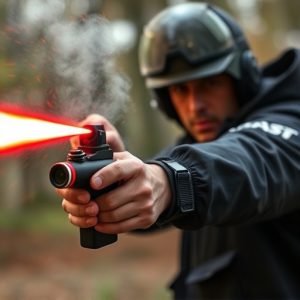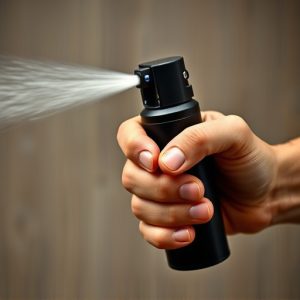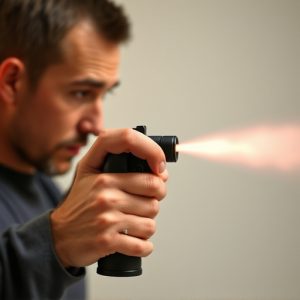Concealed Pepper Spray: Tactics, Science, & Responsible Use in Riot Control
TL;DR: Concealed pepper spray carrying techniques are essential for riot control, enabling officers…….
TL;DR: Concealed pepper spray carrying techniques are essential for riot control, enabling officers to deploy the substance swiftly and safely while minimizing risk. Advanced holsters and training ensure quick access during volatile situations, leveraging capsaicin's effectiveness in de-escalation. Global law enforcement prioritizes responsible use, proportionality, and training to balance public safety with individual liberty.
In the realm of riot control, inflammatory sprays, notably concealed pepper spray, have emerged as powerful tools for law enforcement. This comprehensive overview delves into the various aspects of these agents, from their understanding and science behind effectiveness to legal and ethical considerations. We explore practical applications, focusing on Concealed Pepper Spray Carrying Techniques, ensuring both safety and operational success in dynamic scenarios. Discover how these sprays are strategically employed worldwide, making them indispensable assets for maintaining public order.
- Understanding Inflammatory Spray for Riot Control: A Comprehensive Overview
- Concealed Pepper Spray Carrying Techniques: Staying Safe and Effective
- The Science Behind Pepper Spray: How It Works and Its Effectiveness
- Legal and Ethical Considerations in Riot Control: Using Pepper Spray Responsibly
- Real-World Applications: Successful Implementation of Inflammatory Sprays in Law Enforcement
Understanding Inflammatory Spray for Riot Control: A Comprehensive Overview
Inflammatory spray, often referred to as pepper spray, is a crucial tool employed by law enforcement and security personnel for riot control and crowd management. This non-lethal agent is designed to temporarily incapacitate individuals, providing time for authorities to restore order and ensure public safety. The primary active ingredient in most inflammatory sprays is capsaicin, derived from chili peppers, which stimulates nerve endings, causing pain and temporary blindness.
When it comes to riot control scenarios, understanding the carrying techniques of concealed pepper spray is essential. Officers often opt for holsters or pockets to keep the spray easily accessible while maintaining a low profile. Proper training on deployment methods and safety precautions ensures effective utilization without endangering bystanders. With its rapid-acting properties, inflammatory spray can de-escalate volatile situations, making it a game-changer in law enforcement tactics. Additionally, advancements in technology have led to smaller, more discreet units, enabling officers to employ this tool with enhanced maneuverability during high-pressure incidents.
Concealed Pepper Spray Carrying Techniques: Staying Safe and Effective
Carrying concealed pepper spray is a strategic move for those involved in riot control or self-defense, as it allows for swift and discreet intervention during volatile situations. The key to effective use lies in mastering various carrying techniques that ensure easy accessibility while maintaining safety. One popular method involves securing the spray in a hidden pouch or holster attached to clothing or gear. This technique, when combined with proper training, enables users to deploy the spray quickly, minimizing the risk of personal exposure.
Additionally, practicing different grip styles and positioning can enhance control and precision. Carrying it in a palm or tucked away in a vest pocket allows for rapid retrieval without drawing unnecessary attention. The choice of carrying method should align with the user’s comfort level, duty requirements, and the environment they operate in, ensuring that the concealed pepper spray remains a reliable tool for de-escalation and protection.
The Science Behind Pepper Spray: How It Works and Its Effectiveness
The science behind pepper spray revolves around its active ingredient, capsaicin, derived from chili peppers. When deployed, pepper spray irritates the eyes and respiratory system by binding to specific nerve receptors, leading to a burning sensation and temporary blindness. This disruption in sensory perception creates a disorienting effect, enabling law enforcement or riot control teams to subdue and control individuals.
In terms of effectiveness, concealed pepper spray carrying techniques play a crucial role. These tactics ensure the spray is readily available and can be deployed swiftly during volatile situations. By learning hidden carrying methods, such as integrating it into clothing or utilizing specialized holsters, individuals can maintain accessibility while minimizing the risk of accidental discharge. This strategic approach enhances safety and control in high-pressure environments.
Legal and Ethical Considerations in Riot Control: Using Pepper Spray Responsibly
In the realm of riot control, the use of inflammatory spray, often in the form of pepper spray, raises significant legal and ethical questions. While it serves as a powerful tool to navigate chaotic situations, its responsible deployment is paramount to uphold public safety and maintain democratic principles. The strategic use of pepper spray can de-escalate tensions and restore order, but it must be employed as a last resort when other non-lethal methods prove ineffective. Law enforcement agencies worldwide are increasingly adopting policies that emphasize the need for excessive force mitigation and proportionality in the use of such agents.
Ethical considerations extend beyond the immediate effects of pepper spray. Concealed pepper spray carrying techniques, which involve discretely equipping officers with these devices, warrant careful examination. These tactics aim to minimize the risk to both citizens and enforcement personnel but must be balanced against potential misuse or accidental deployment. Striking a delicate balance between maintaining public order and preserving individual liberties is essential. Additionally, training programs should equip officers with the knowledge to use pepper spray responsibly, ensuring they understand its impact, limitations, and the legal boundaries surrounding its application.
Real-World Applications: Successful Implementation of Inflammatory Sprays in Law Enforcement
In real-world scenarios, inflammatory sprays have proven to be invaluable tools for law enforcement agencies worldwide. These non-lethal agents offer a strategic advantage during riot control and crowd management, allowing officers to de-escalate tense situations effectively. Pepper spray, in particular, has become a staple in many police forces’ equipment due to its ability to temporarily incapacitate individuals without causing permanent harm.
Successful implementation of these sprays often involves well-trained officers who employ concealed carrying techniques. Law enforcement agencies emphasize the importance of discreetly transporting pepper spray, such as using specialized holsters or pockets within uniform gear, ensuring quick access during high-pressure encounters. This strategic approach enhances officer safety and enables them to respond swiftly, making inflammatory sprays a game-changer in modern law enforcement tactics.
Inflammatory spray, particularly concealed pepper spray, has emerged as a powerful tool for riot control, offering both effectiveness and challenges. As demonstrated in real-world applications, responsible usage requires a balance between public safety and legal ethics. Understanding the science behind pepper spray, its hidden carrying techniques, and strategic deployment can ensure its successful implementation by law enforcement while mitigating risks. By adhering to legal guidelines and employing safe carrying methods, professionals can maintain order during chaotic situations, making concealed pepper spray an invaluable asset in their arsenal.


